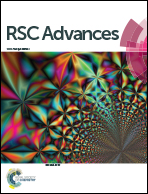Highly portable fluorescent turn-on sensor for sulfide anions based on silicon nanowires†
Abstract
By covalently modifying 3-[2-(2-aminoethylamino)ethylamino]propyl-trimethoxysilane (ligand) and 4-amino-1,8-naphthalic anhydride (fluorophore) onto the surface of silicon nanowires (SiNWs) and subsequently complexing them with copper ions (Cu2+), a SiNWs-based fluorescent sensor for sulfide anions (S2−) was realized. Based on such a ligand/Cu2+ approach, the new type of sensor realizes rapid sensing of S2−, and exhibits high sensitivity and selectivity for S2− in water. Moreover, the as-prepared SiNW arrays-based sensor was successfully used in real time and in-situ monitoring of S2− in running water by directly inserting it into the water. The present SiNW arrays-based sensor can be developed into a portable commercial device applied in environmental analysis after further optimizing the technique and finely quantifying the response of the sensor.


 Please wait while we load your content...
Please wait while we load your content...